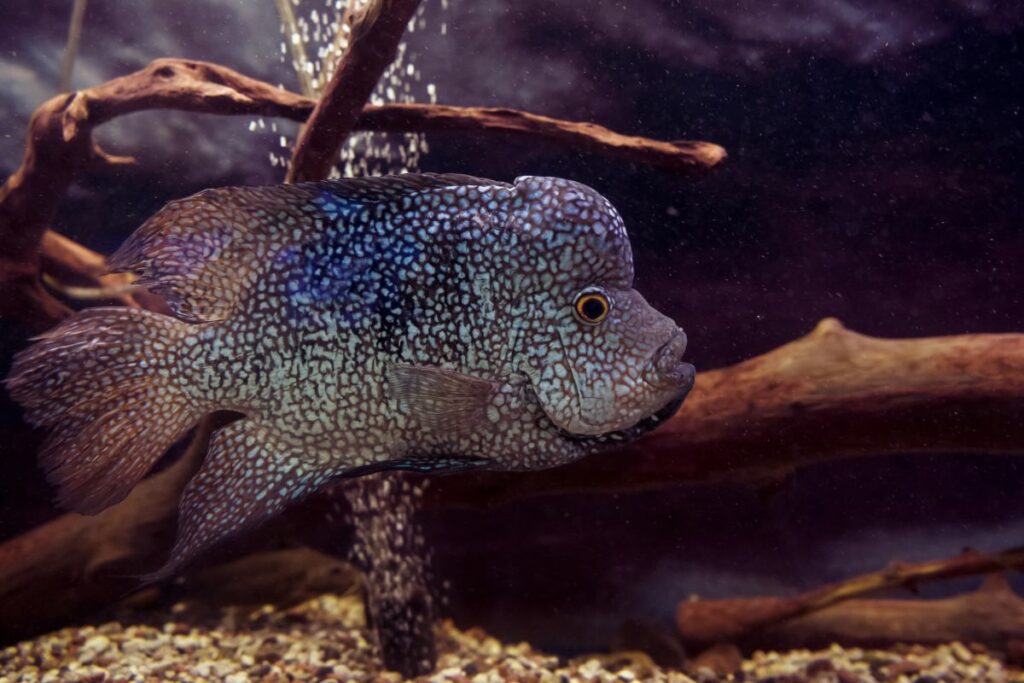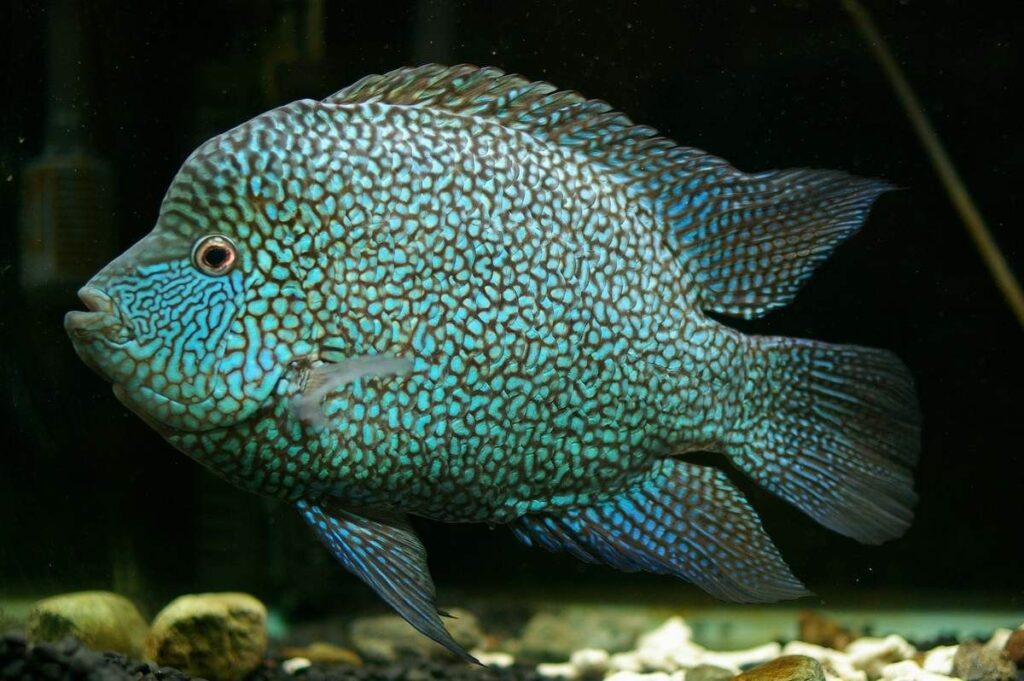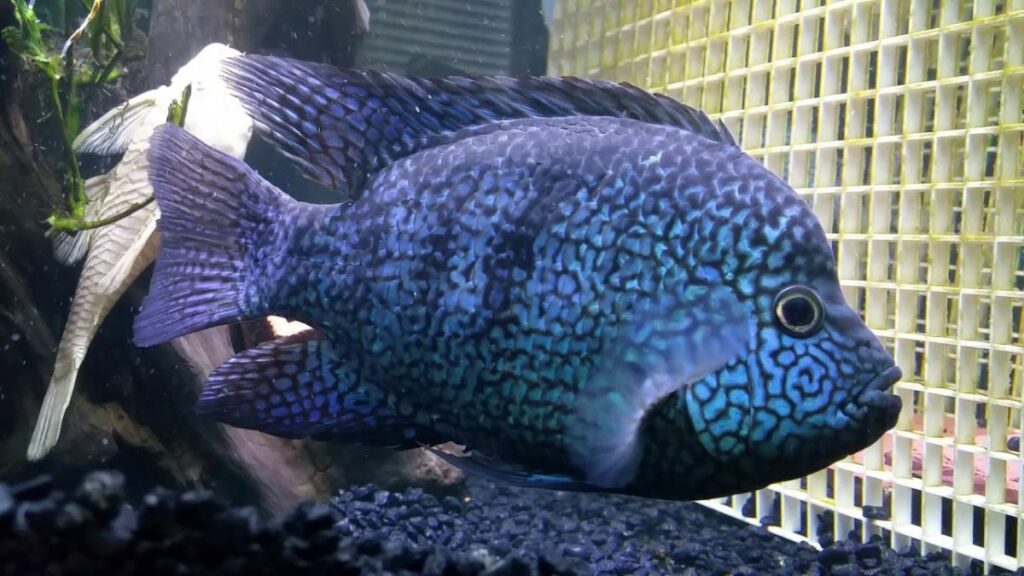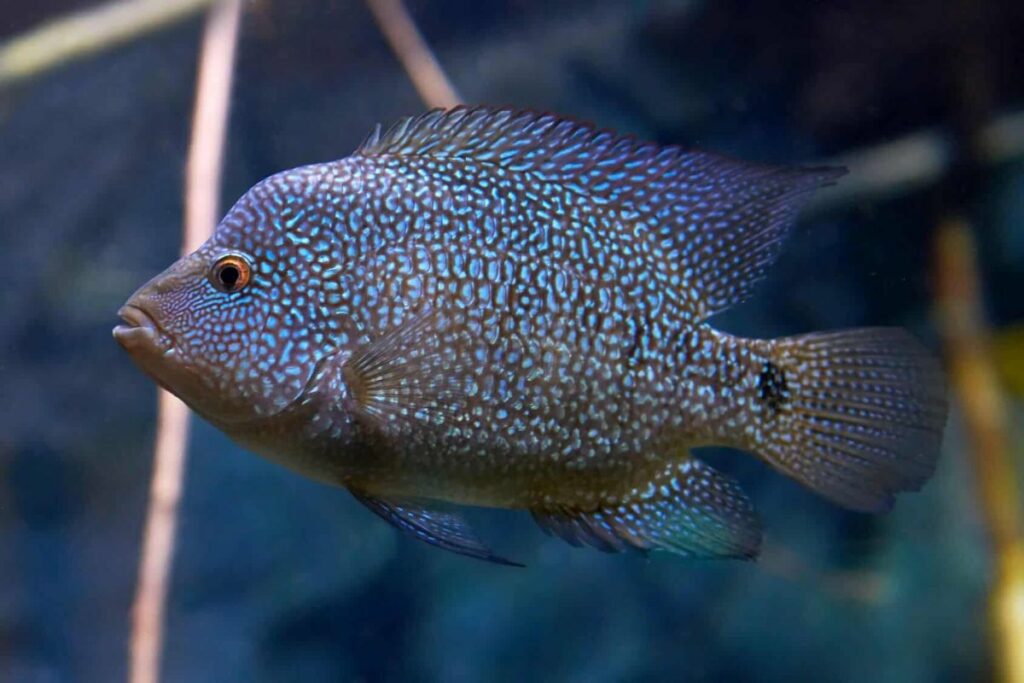The Electric Blue Texas Cichlid will catch your eyes in an instant. Brilliant blue spangles and an intense red eye that watches you from inside of the tank makes these fish a favorite for cichlid collectors.

Like other large fish they often recognize their owners. And like other cichlids they are devoted parents to their young. What better fish to turn a large tank over to than a pair of Blue Texas Cichlids?
What is the Blue Texas Cichlid?
First off, the name “Texas Cichlid” is a little incorrect when talking about the Blue version. The true Texas Cichlid is Herichthys cyanoguttatus. It is a pale silver to light blue and gray fish. It is the only cichlid that lives in the United States. You will see Texas Cichlids in Central and South Texas and down into Mexico.
The Electric Blue Texas Cichlid is a different species: Herichthys carpintis. Unlike H. cyanoguttatus, the Electric Blue is just found in Mexico. It is also known as the Pearlscale or Lowland Cichlid. But the resemblance to the true Texas Cichlid is so strong that the two fish share the common name.
Blue Texas Cichlids are even more beautiful. They have bold, blue scales against a black background and maintain their colors even when not breeding. Electric Blue Texas Cichlid size is also a little smaller, reaching full length at around 8 inches (vs 10-12 for the true Texas Cichlid).
Electric Blue Texas Cichlids are just as hardy as their cousins and are easy to breed in captivity. If you succeed you will find plenty of aquarists willing to buy some from you. But how do you find one of these fish in the first place?
- Common Names: (Electric) Blue Texas Cichlid, Pearlscale Cichlid, Lowland Cichlid
- Scientific Name: Herichthys carpintis
- Origin: Texas, Mexico
- Length: 8 to 10 inches
- Aquarium Size: 40-55 gallons
- Temperament: Aggressive
- Ease of Care: Very Easy
Where to Find Electric Blue Texas Cichlid For Sale?
Finding an Electric Blue Texas Cichlid is a little challenging as these fish are always in high demand. Blue Texas Cichlid price is higher than the regular Texas Cichlid.
You should expect to pay $10-20 for an Electric Blue vs $5 for a normal Texas Cichlid. But the beauty of the vibrant blue scales just increases as the fish grow older.
I recommend shopping for fish online if you can’t find a Blue Texas Cichlid at your local aquarium store. Aquatic Arts and other specialty wholesalers also sell to individuals that enjoy rare fish like this cichlid.
While you do pay extra for shipping it may be the one way you score such a unique fish.
Electric Blue Texas Cichlid Care
Finding an Electric Blue Texas Cichlid might be a little challenging. But once you have them these fish are very easy to care for and long lived as well.

Blue Texas Cichlid Size
The Blue Texas Cichlid will reach 8 to 10 inches when full grown, a little smaller than the true Texas Cichlid. Therefore, an aquarium of 40 (breeder) to 55 gallons is a good minimum for one or even a breeding pair.
Keep in mind that this is an aggressive cichlid, however. A small tank may not give tank mates enough room to avoid a Blue Texas Cichlid in a bad mood. More space is better (55-75 gallons) if you intend on keeping other species of fish with these cichlids.
Plants and Decorations for Blue Texas Cichlids
Aquascaping a Blue Texas Cichlid aquarium gets harder the older your fish get. Like other large cichlids they love digging into the substrate, moving gravel around to form deep pits. This is just in the nature of many cichlids to do and there is little you could do about it.
If your Blue Texas Cichlids decide to breed then they will do even more digging in preparation. Offer them a hard surface, like a flat rock, for them to deposit their eggs on.
Any plants rooted in the substrate will get pulled up if the Texas Cichlid decides they are in the way of a digging project. Plants and mosses that attach themselves to hard surfaces will work, however. Java Moss and Java Fern are hardy, popular choices for a planted cichlid aquarium.
Water Conditions for the Blue Texas Cichlid
All Texas Cichlids prefer water conditions that are moderate in all aspects. The pH should fall between 6.5 and 7.5, though more alkaline water is also acceptable. Blue Texas Cichlids are not picky when it comes to general and carbonate hardness as well, preferring the same conditions that tap water contains. They will even breed in hard water with ease.
The water temperature should fall between 72 and 78°F, with a few degrees colder or warmer in either direction well tolerated. If you are trying to breed your Texas Blue cichlid then keep conditions on the warmer end of the spectrum.

The Texas Blue Fish Cichlid is also hardy in the presence of ammonia and other nitrogenous waste products. If you know your fish are wild caught then you need to be more careful since their native waters are free of pollutants.
But captive-bred Texas Cichlids are tolerant of mildly elevated ammonia, nitrite, and nitrate levels. That’s no excuse not to perform regular water changes and filter maintenance, however.
Feeding Electric Blue Texas Cichlids
The Blue Texas Cichlid needs a carnivorous diet. In the wild these fish feed on smaller fish plus invertebrates like worms, shrimp, and snails. But in captivity they adjust well to a cichlid pellet formula that is rich in animal protein.
Flakes might also be offered to baby Electric Blue Texas Cichlids but they will outgrow them soon. Since flakes are so messy pellets are the best option for feeding.
Take time to read the ingredients label as well because cheaper food blends use poor quality filler products. Potato starch, wheat, soy, corn, and so on. Animal protein should be the first few main ingredients in any food for Texas Cichlids. And if it’s enriched with vitamins and color enhancing pigments, even better.
Along with your chosen cichlid pellet formula offer frozen and live foods a few times per week. When Electric Blue Texas Cichlids are young they will eat brine shrimp, bloodworms, tubifex worms, and other food for smaller aquarium fish.
Once they get closer to their final adult size you should switch to earthworms, ghost shrimp, mealworms, crickets, and other savory treats. I don’t recommend offering feeder fish unless you raise them yourself. Pet store feeder fish are full of bacteria and parasites that will get passed on to the predator that eats them.
You should feed a young Blue Dot Texas Cichlid three times per day, reducing their feedings to twice per day as they grow older.
Electric Blue Texas Cichlid Tank Mates
Electric Blue Texas Cichlid tank mates should be chosen with care as these are a pretty aggressive cichlid. Not as aggressive as Red Devils, Umbee Cichlids, and other Central American fish. But still mean enough to bully and even kill tank mates they don’t like.
Blue Texas Cichlids are good members for a mixed cichlid community tank as well. They will get along well with other medium to large cichlids as long as all of the fish have space to claim a territory.
The aquarium should be 75 gallons or larger in volume, with plenty of decorations. Driftwood, rocks, and other additions break up the line of sight and form clear boundaries that the fish will respect.
Any other fish should be fast moving so they can avoid aggressive lunges. Tinfoil Barbs, Silver Dollar fish, and Giant Danios are all large and fast enough to live alongside Blue Texas Cichlids. They are also too big to be eaten.

Blue Texas Cichlid Breeding
Once young Electric Blue Texas Cichlids reach 2 to 3 inches in length they are old enough to breed. Telling apart males from females is a little more difficult compared to other cichlids. The older your fish get the easier it becomes.
Electric Blue Texas Cichlid Male or Female?
A male Blue Texas Cichlid is a lot larger than a female. He will also grow a nuchal hump on his forehead. Not as large as that of other cichlids but still noticeable. The female will be plumper, smaller, and not as bright colored. She will have a dorsal and anal fin that is a little less pointed than a male Texas Cichlid.
Texas Cichlids are substrate spawners and seek out a flat, hard surface to lay their eggs on. A nice, flat rock, such as a piece of slate, is the perfect breeding platform for a pair. Otherwise they will dig down to the aquarium glass at the bottom of your tank and lay their eggs there.
Like all cichlids they are excellent parents. Texas Cichlids will lay around 3,000 eggs that they then defend from any predators. Once the fry hatch they remain in a cloud surrounding the parents until they are old enough to fend for themselves.
Any tank mates should be removed before the fish spawn. Otherwise they will be killed by the vicious parents.
Conclusion
The Electric Blue Texas Cichlid is a large and impressive fish from North America. They are more unusual than most species you find in pet stores. But are still quite hardy and easy to care for. Breeding them is a satisfying project to take on as well and it will be easy to sell the fry to local aquarists.
More Frequently Asked Questions About the Electric Blue Texas Cichlid
Electric Blue Texas Cichlid care is not at all difficult so long as you have a large enough aquarium for them. But since they are so rare I do get the following frequently asked questions about these fish at times.
The Texas Blue Cichlid is a little smaller than the true Texas Cichlid. They reach 8 to 10 inches when full grown. Versus 10 to 12 inches for their larger cousin.
The Blue Texas Cichlid is a relative of the true Texas Cichlid. Except the Blue species lives in Mexico. Both fish are very similar to one another; the true Texas Cichlid is more silvery and light blue compared to the Electric Blue species.
The internet is the best place to find an Electric Blue Texas Cichlid. Online auction websites are also worth checking as these cichlids are always in demand. Specialty local aquarium stores sometimes have them in stock as well. They may even special order some for you if you ask.

